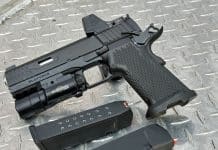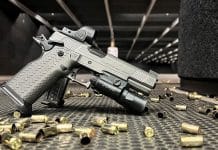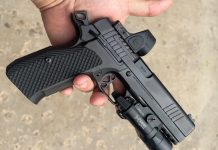The San Antonio-class amphibious warfare ship (technically an LPD, for Landing Platform Dock) has recently begun entering service with the U.S. Navy. The class lead, USS San Antonio (LPD-17), was commissioned in January 2006 and made its first deployment in August 2008. Since then, the New Orleans (LPD-18) was commissioned in March 2007, followed by the Mesa Verde (LPD-19) in December 2007, the Green Bay (LPD-20) in January 2009, and the New York (LPD-21) in November 2009. (The New York is notable for including 24 tons of steel from the World Trade Center in its hull.) Additional ships now under construction or planned are the San Diego (LPD-22), the Anchorage (LPD-23), the Arlington (LPD-24), the Somerset (LPD-25), and the Murtha (LPD-26).
The San Antonio and her sister ships are intended to replace four different existing amphibious ship classes: the LPD-4, LSD-36, LKA-113, and LST-1179. It is specifically designed to support what the Marine Corps calls its “mobility triad”: the landing craft, air cushioned (LCAC), the advanced amphibious assault vehicle (AAAV), and the MV-22 Osprey tiltrotor VTOL aircraft.
The ships feature a floodable well deck with a stern ramp that can accommodate two LCACs and a helipad on the deck above that can hold two CH-53E Sea Stallions, six AH-1W Super Cobra attack helicopters, four CH-46 Sea Knights, or two Ospreys. Cargo and accommodation spaces on the vessel will hold 700 troops and 14 AAAVs, plus over 25,500 cubic feet of cargo and ammunition and 1,234 cubic meters of fuel (as cargo).
Extensive automation has reduced the crew requirement to 361. The hull has a reduced radar cross section, improved nuclear blast and fragmentation survivability, and shock hardening. All sensor masts are enclosed in eight-sided structures that are selectively frequency-transparent, serving to both reduce the radar signature and protect the masts from the elements.
Though the armament is purely defensive, the San Antonio-class LPDs mounts two launchers for the Raytheon RIM 116 surface-to-air missile, which is also capable of intercepting anti-ship missiles. Space has been allocated for the Evolved Sea Sparrow Missile (ESSM) system, and for close-in defense the ships have two Mark 46 Mod 2 30mm chain guns and two Mark 26 Mod 18 .50-caliber machine guns.
The LPDs have a total of five radars: the AN/SPS-48E air search radar, the AN/SPS-64(V)9 navigational radar, the AN/APQ-9B surface search radar, and two AN/SPS-73 surface search radars. San Diego (LPD-22) will receive the ship self-defense system (SSDS), which integrates the radar, electronic warfare suite, and infrared sensors; SSDS will be retrofitted to earlier ships in the class later. These vessels also have decoy systems designed to defeat torpedoes and anti-ship missiles.
The San Antonio-class has experienced a number of construction and cost overrun issues, but these problems are gradually being resolved, and the final unit is scheduled for delivery in 2015.












